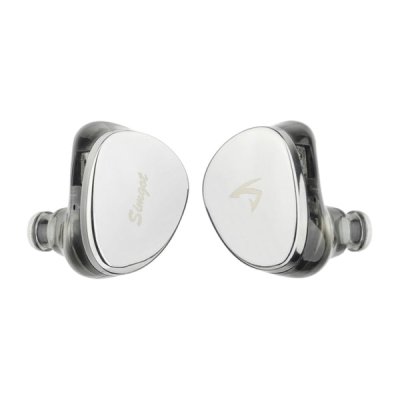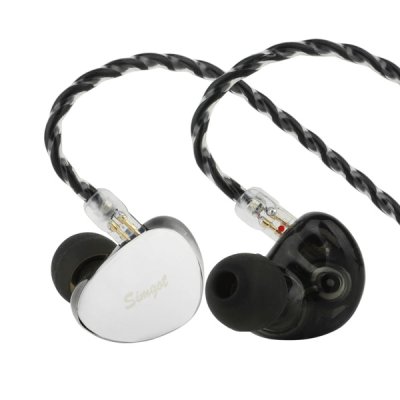Tanchjim Fission and SIMGOT EG280 use 1DD and 1DD+1Planar driver setups respectively. Tanchjim Fission costs $130 while SIMGOT EG280 costs $79. Tanchjim Fission is $51 more expensive. Tanchjim Fission holds a clear 0.5-point edge in reviewer scores (7.1 vs 6.6). SIMGOT EG280 has slightly better bass with a 0.3-point edge, SIMGOT EG280 has significantly better dynamics with a 1.2-point edge, SIMGOT EG280 has better details with a 0.7-point edge and SIMGOT EG280 has better imaging with a 0.7-point edge.
Insights
| Metric | Tanchjim Fission | SIMGOT EG280 |
|---|---|---|
| Bass | 6.6 | 6.9 |
| Mids | 6.9 | 6.7 |
| Treble | 6.8 | 6.7 |
| Details | 6.3 | 7 |
| Soundstage | 6.9 | 7 |
| Imaging | 6.7 | 7.4 |
| Dynamics | 5 | 6.2 |
| Tonality | 7.3 | 7.1 |
| Technicalities | 7.1 | 7.5 |
Tanchjim Fission Aggregated Review Score
Average Reviewer Scores
Average Reviewer Score:
7.1Generally Favorable
SIMGOT EG280 Aggregated Review Score
Average Reviewer Scores
Average Reviewer Score:
6.6Cautiously Favorable
Reviews Comparison
Tanchjim Fission reviewed by Paul Wasabii
Youtube Video Summary
Tanchjim Fission follows the brand's long-arc approach with a full bass arc and upper mids set just under Harman, yielding natural lower mids and balanced male/female vocal weight. A four-way switch plus three swappable, clearly labeled nozzles alter geometry subtly and nudge treble/texture, so cycling nozzles matters; in total there are up to twelve tuning combinations that stay coherent rather than gimmicky.
Compared with Origin, bass sits lower/back on the stage, freeing space for vocals and instruments; presentation is bigger and airier with better imaging and layering. Mids are more neutral in weight and closer to the open “Oxygen” style than the thicker, in-head feel of Origin, which helps EDM and mixed-genre playlists sound cleaner while avoiding mid-bass bloat.
Technical resolve is modest for the class: detail retrieval trails the stage/imaging strengths, and treble extension is good but not top-tier for a dynamic driver. Value is price-appropriate; pick the most resolving nozzle and consider lowering bass via the switch. The modular USB-C DSP connector and app add five sensible warm U-shaped presets—this brings real versatility—whereas a CS43198 “Luna”-type dongle tends to flatten depth, making the DSP path the preferable pairing.
Paul Wasabii Youtube Channel
Buy Tanchjim Fission on HiFiGO
Ad
Price: $129.99
Buy Tanchjim Fission on HiFiGO
SIMGOT EG280 reviewed by Paul Wasabii
Youtube Video Summary
Hybrid gaming set built around a 10 mm dynamic driver and a 6 mm planar, plus a USB-C DSP dongle and a 1.7 m cable. Stock tuning follows a Harman-style balance with a modest bass shelf and a slightly brighter upper range, which favors imaging, FX clarity, and footsteps in shooters. Technical performance is solid for the class: the planar adds resolve without obvious planar timbre, making the set feel more like a clean hybrid than a pure DD.
The idea here is presets: SIMGOT provides app control and WalkPlay hosts multiple music and game modes as well as community uploads, so the EG280 is best treated as a flexible DSP platform. For music, a gentle low-Q tilt (bass up a few dB, treble down a touch) yields a more fun, less fatiguing listen; stage is serviceable rather than wide, while detail retrieval and positional cues remain a strength. Overall, it is a capable, EQ-friendly gaming hybrid that can double for music with minimal EQ, but out-of-box brightness means it benefits from presets to shine.
Paul Wasabii Youtube Channel
Buy SIMGOT EG280 on Linsoul
Ad
Price: $79
Buy SIMGOT EG280 on Linsoul
Tanchjim Fission reviewed by Jays Audio
Youtube Video Summary
The Tanchjim Fission presents a neutral, balanced, and clean sound signature that is also described as smooth and full. It offers a very natural and laid-back listening experience, making it a strong option for those seeking a safe, non-fatiguing tuning. The technical performance is solid for its price, with good detail retrieval and instrument separation, though it isn't the most dynamic or sparkly set available.
Tip selection is crucial, with recommendations for the Tri Clear or Final E tips to open up the sound, while the Spinfit CP155 can add a touch more bass. The included tuning switches are largely seen as a gimmick; only the middle silver setting is recommended, as the others introduce a significant sub-bass roll-off. The Fission excels with genres like rock, indie, acoustics, and classical at moderate volumes, but its lack of sub-bass rumble and extension makes it a weak choice for hip-hop, EDM, or rap.
Its greatest strength is its value proposition, as it is essentially a cheaper version of the Tanchjim Origin, sharing the same driver and sound profile for a lower cost. This makes competitors like the Moondrop Kato seem less relevant. However, when compared to other all-rounders like the Juzear 4U or Simgot EW300, the Fission faces stiff competition. The EW300, in particular, offers more bass, tuning variety, and similar technicalities for half the price, making the Fission a tougher sell unless its specific brand of smooth, neutral tonality is exactly what you're after.
Jays Audio Youtube Channel
SIMGOT EG280 reviewed by Jays Audio
Youtube Video Summary
SIMGOT’s EG280 comes tuned as a balanced all-rounder with a touch of upper-mids/vocal emphasis. The bass is thumpy, full, and clean—adding weight without bleed or warmth bloat—while a slightly forward midrange brings clarity and presence to voices. A purposeful 4–8 kHz dip keeps the set from turning shouty, and the treble—handled by planars—stays natural without the zingy “planar timbre.” Extension is adequate to mildly airy, revealing small details without sounding artificial.
There is a caveat: a 13 kHz peak can pop up on brighter K-/J-Pop or lean mixes, so mid listening levels (~70–75 dB) are the sweet spot. Technically it sits above EW300 but slightly below EA500 LM/EM6L, trading max microdetail for a more natural, less bright tonality. Genre fit is broad—from pop and indie to electronic—so long as volume isn’t cranked. Tip pairing favors smoother or bass-adding tips (e.g., Final E, Softears Ultra Clear) over anything that pushes treble further.
Imaging is a standout for the price, giving gunshots and footsteps extra pop without harshness, which makes the EG280 surprisingly solid for gaming. The lightweight build and low-microphonic cable boost comfort for long sessions. Overall, think safe, balanced, and versatile rather than showy “special sauce”: a set that’s easy to live with, competitive in value, and a smarter pick for mixed music + gaming than brighter, sharper peers—just mind that upper-treble spike on hot masters.
Jays Audio Youtube Channel
Tanchjim Fission reviewed by Head-Fi.org
SIMGOT EG280 reviewed by Head-Fi.org
Tanchjim Fission reviewed by Web Search
The Tanchjim Fission delivers a notably neutral with vocal-forward presentation in its default configuration, emphasizing clarity and articulation in the midrange without excessive coloration. Bass response is described as clean and firm, offering good texture without bleeding into the mids, while the treble remains smooth and non-fatiguing, contributing to an overall balanced yet engaging listen. Its standout feature is the extensive customization: three swappable nozzle filters (brass for warmth, titanium for brightness, stainless steel for neutrality) and a four-position analog tuning dial collectively enable 12 possible tuning combinations, allowing significant user adjustment to suit genre or preference.
Technically, the Fission leverages Tanchjim’s fifth-generation DMT5 dynamic driver, shared with their higher-end Origin model, which contributes to strong detail retrieval and a surprisingly expansive soundstage for a single-DD IEM at this price. The lightweight CNC-machined aluminum shells ensure comfort during extended use, though isolation can vary and may require tip rolling for an optimal seal. The package includes a practical soft case, a modular silver-plated cable with 3.5mm, 4.4mm, and USB-C (featuring DSP and app-based parametric EQ) terminations, rounding out a strong value proposition at $129.99.
SIMGOT EG280 reviewed by Web Search
The SIMGOT EG280 is a budget-class, hybrid gaming IEM that pairs a 10 mm dynamic driver with a 6 mm planar unit per side (rated at 32 Ω, 119 dB/Vrms), a configuration positioned to blend bass weight with fast mid/treble transients. Packaging is unusually comprehensive at this price: a long ~1.7 m 2-pin cable with inline mic plus a bundled USB-C DAC that works with the SIMGOT Control app for preset EQ and game profiles, making it plug-and-play across phones and laptops. Street pricing has launched around ¥299 / ~$42–45, putting it squarely in value territory for an entry gaming set. .
On tonality and performance, the EG280 is pitched for positional accuracy and clarity—marketing materials emphasize “seamless frequency transition” and game-oriented EQ options—so expectations should lean toward a mildly U-shaped balance with clean mids and crisp upper registers rather than basshead emphasis. Early community impressions and graphs likewise frame it as a clear, energetic listen with solid imaging for competitive titles, while the included DAC/app path offers useful tailoring if treble sheen or bass quantity needs trimming for long sessions. At the price, technicalities (detail retrieval, imaging precision) are respectable; staging depth and macrodynamics are more modest, which is typical in this cost bracket. .
Tanchjim Fission (more reviews)
Tanchjim Fission reviewed by Jaytiss
Youtube Video Summary
The Tanchjim Fission presents fantastic value right out of the box, largely thanks to its inclusion of a high-quality USB-C DAC cable with 3.5mm and 4.4mm terminations. The all-metal build feels premium, and the included cable is extremely silky and pleasant to use. A standout feature is the set of interchangeable nozzles that allow for sound tuning; the gold nozzle is the clear winner, providing the best balance, while others can make the bass less impactful. However, the fit can be a challenge for some as the shell lacks a pronounced lip, and the nozzles can be tricky to remove and replace.
Sonically, the Fission is extremely close to the more expensive and beloved Tanchjim Origin, offering a smooth, energetic sound with a tonality that is highly enjoyable. It provides a touch of warmth, pristine detail, and good air, making it a set that is easy to recommend and daily drive. When compared to other sets in its price range, it holds its own against competitors like the Dunu Kima (which has better fit and accessories) and the Kiwi Ears Quintet (which offers more bass), though the choice ultimately comes down to personal preference for tonality and the value placed on its tunable nature.
While it doesn't break the so-called "curse of the $150 IEM," the Fission is a strong contender and gets a full recommendation. Its few cons include a fit that may not work for all ears and a bass quantity that some may wish was greater. For those who value its specific sonic qualities, the excellent build, and the incredible package value with the included DAC cable, the Tanchjim Fission is a fantastic and competitive option that is very easy to enjoy.
Jaytiss Youtube Channel
Tanchjim Fission reviewed by Z-Reviews
Youtube Video Summary
The Tanchjim Fission is an absolutely spectacular IEM that feels and performs far beyond its $129 price tag. It comes loaded with a ridiculous amount of customization, featuring three interchangeable nozzles (stainless steel, titanium, and brass) and a four-way tuning switch, creating a potential 12 different sound combinations. The entire package feels flagship-tier, boasting an excellent interchangeable cable system with 3.5mm, 4.4mm, and USB-C terminations, a waterproof bag, and even a keychain tool for adjustments.
After extensive testing, the definitive "cheat code" for the best sound is using the brass nozzles with the tuning switch set to Pop mode, which seemingly bypasses internal circuitry for a pure, direct sound. This configuration delivers exceptional clarity and a surprisingly wide soundstage, though they are not bass monsters. The fit is excellent, passing the "pinky test," and the build quality on everything from the IEMs themselves to the accessories is exceptional.
While not every combination of nozzles and switches is a winner, the sheer number of options ensures you can find a sound you love. For the price, the value is unmatched, feeling like a product that should cost $279. It comes as a full recommendation, offering a premium, highly tunable experience that is arguably one of the best deals in the IEM market, cementing Tanchjim's reputation for making no bad gear.
Z-Reviews Youtube Channel
Tanchjim Fission reviewed by Super* Review
Youtube Video Summary
Tanchjim Fission comes in at $130 with a quirky onboard tuning dial that offers four bass positions—but every setting trends toward modest bass anyway, making the adjuster more novelty than necessity. The default “bass-max” profile presents that familiar single-DD contrastiness with a bit of dynamic punch, a slightly bright/forward tilt, and overall inoffensive treble. It never tips into harshness or sibilance, but the bass attack reads a touch pillowy and the whole presentation stops short of truly incisive.
In direct comparison, it’s more comfortable tonally than the spikier sets yet less engaging and less tight than the standouts, settling into a solid C-tier alongside other “fine but unremarkable” options. Resolution and imaging are serviceable, treble stays safe, and the included cable is surprisingly nice, but there’s not enough slam or bite to push it up the chart. Net result: a competent, easy-listen single-DD for those who value smoothness over excitement, with limited payoff from that bass dial.
Super* Review original ranking
Super* Review Youtube ChannelSIMGOT EG280 (more reviews)
SIMGOT EG280 reviewed by
 Fresh Reviews
Fresh Reviews
Youtube Video Summary
The SIMGOT EG280 makes a strong first impression for budget gaming with a curve reminiscent of Harman 2019: footsteps (both low and upper registers) and gunfire pop through cleanly, giving deathmatch sessions a snappy, almost B+-tier feel. However, once the action shifts to coordinated 5v5 play, the mix starts to blur—layering behind walls turns into a “mashed potato” effect, and horizontal cues lack the tactile edge that marks exact peeks and thresholds.
In Valorant and Apex, the same pattern holds: respectable general imaging, but depth perception and separation take noticeable hits when the battlefield gets chaotic. Smokes, thermites, ultimates, and sustained gunfire mask lighter cues—leading to those “where did this guy come from?” moments—and vertical readouts feel approximate rather than pinpoint. Overall placement sits around a B- for both titles: a pleasant, airy presentation that’s easy to enjoy in lighter modes, but not the clearest tool for high-level competitive awareness when the screen fills with abilities and crossfire.
Fresh Reviews original ranking
Fresh Reviews Youtube ChannelTanchjim Fission Details
Driver Configuration: 1DD
Tuning Type: Neutral, Vocal-focused
Brand: TANCHJIM Top TANCHJIM IEMs
Price (Msrp): $129.99
Support our free service! Buying through our affiliate links costs you nothing extra:
SIMGOT EG280 Details
Driver Configuration: 1DD+1Planar
Tuning Type: U-Shaped
Brand: Simgot Top Simgot IEMs
Price (Msrp): $79
Support our free service! Buying through our affiliate links costs you nothing extra:
Tanchjim Fission User Review Score
Average User Scores
Average User Score: n/a
Based on 0 user reviews
No user reviews yet. Be the first one who writes a review!
SIMGOT EG280 User Review Score
Average User Scores
Average User Score: n/a
Based on 0 user reviews
No user reviews yet. Be the first one who writes a review!
Tanchjim Fission Gaming Score

Gaming Score & Grade
- The gaming score is prioritizing technical capabilities of the IEM (Separation, Layering, Soundstage) and good value.
Gaming Score
7.2Gaming Grade
A-SIMGOT EG280 Gaming Score

Gaming Score & Grade
- The gaming score is prioritizing technical capabilities of the IEM (Separation, Layering, Soundstage) and good value.
Gaming Score
7.4Gaming Grade
A-Tanchjim Fission Scorings
Average Technical & Tuning Grades
Average Tunign Grade
A-- The tonal character feels settled and versatile, with just a few gentle bumps. You can listen for hours without fatigue.
Average Technical Grade
A-- Technical chops are reliable, pairing tidy separation with a soundstage that stays conservative. Micro-detail is decent, though never spotlighted.
SIMGOT EG280 Scorings
Average Technical & Tuning Grades
Average Tunign Grade
A-- A smooth, agreeable balance keeps the presentation engaging without obvious flaws. Only sensitive ears will nitpick the bumps.
Average Technical Grade
A- It manages detail and layering well enough, even if the stage feels only moderately sized. You get a clear sense of left and right, if not depth.
Tanchjim Fission User Reviews
"This is an example review"
Pros
- Example pro 1
- Example pro 2
Cons
- Example con 1
- Example con 2
Share your experience and build your personal ranking list.
You need to be signed in to write your own reviewSIMGOT EG280 User Reviews
"This is an example review"
Pros
- Example pro 1
- Example pro 2
Cons
- Example con 1
- Example con 2
Share your experience and build your personal ranking list.
You need to be signed in to write your own reviewFind your next IEM:
IEM Finder Quiz
newIEM Comparison Tool
newVS





















